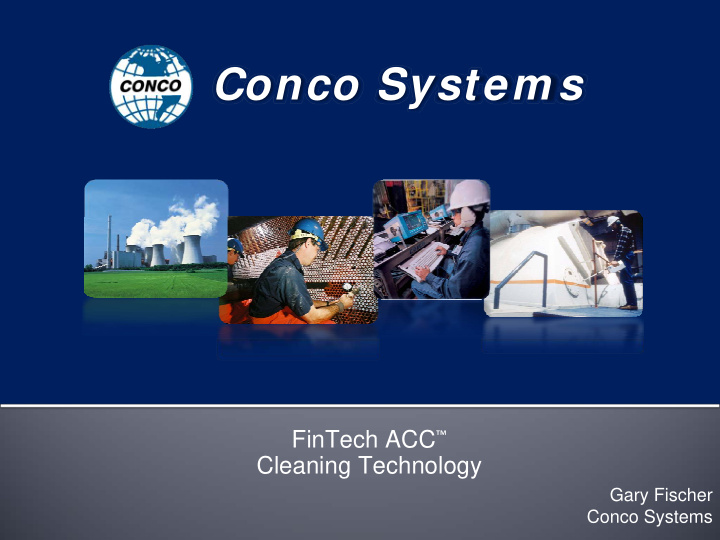



Conco System s FinTech ACC ™ Cleaning Technology Gary Fischer Conco Systems
ACC Features � A-Frame Construction � Finned tubes � Parallel Flow Condensing Sections � Counter Flow Condensing Sections � Fans located in Base of A-frame � Lengthy and large diameter exhaust piping prone to air inleakage
Air-Cooled Condensers Air has low thermal conductivity, low density and low � heat capacity Large surface area required � Installed cost tends to be more expensive than their � water-cooled equivalents An energy penalty can be incurred during summer � conditions EPA does not consider air cooling to be the Best � Available Technology (BAT)
Air-Cooled Condensers Air cooling may be the only practical condensing technology for certain sites � Mine-mouth power plant with inadequate local cooling water source (Black Hills, WY) � Plant situated in a desert (El Dorado, NV) � Cooling tower plume and fog would endanger highway safety (Wyodak, WY) � Thermal pollution with once-through system must be avoided (Athens, NY) � Conventional cooling towers intrude on rural landscape or degrade a residential area, making a permit difficult to obtain
Parallel Flow Panels
Deaerator Panels
Instrumentation
Operating Criteria � Ambient Air Temperature � Air temperature rise across tube banks � Pressure drop across tube banks � Pressure rise across fans � Condenser back pressure � Condenser Duty: Q = W cond (H vap – H liq )
Fouling Tendencies � Finned tubes are very prone to collect pollen, dust, leaves, insects, plastic bags, bird carcasses, etc. � Anything on the ground is fair game � Water, sometimes sprayed on tubes during high ambient temperature periods, can lead to the formation of scale on tube fins thus reducing the heat transfer rate
Fouled External Finned Surface
Impact of Fouling � Poor heat transfer � Higher operating costs � Increased power supply of fandrive Motors � Deterioration of turbine back pressure � Restricted MW output
Cleaning Techniques Three principal methods of cleaning an air cooled condenser: � Fire hose � High pressure hand lance � Automated cleaning machine
Fire Hose � High volume of water but low washing effect � Unit must be taken out of service and scaffolding erected � Requires operator to climb on ACC which can be hazardous � Improvements are quite small, since only a portion of debris is removed, remainder being compacted between tube fins
High Pressure Hand Lance � Low water consumption and a high water pressure � Latter can damage galvanized surfaces and/or snap off fins � Unit must be taken out of service and scaffolding erected � Requires operator to climb on ACC which can be hazardous � Improvements are marginal since only portion of debris is removed, remainder being compacted between tube fins
Automated Cleaning Machine � Significant volume of water but at a pressure that avoids fin and tube surface damage � Water contains no additives � Nozzle beam optimally matched to tube bundle geometry with a constant jet angle � Nozzle design, distance from surface and water jet energy adjustable � Carriage moves at a constant speed � No need to shut unit down or erect scaffolding � System remotely operated for maximum operator and ACC safety � Fouling removed effectively and uniformly
Vertical Applications
Computer Driven Carriage
Nozzle Satisfies Fin Geometry
Full Dimensional Clean
Horizontal Applications
Case Study Rosebud Operating Services Billings, Montana
Case Study Rosebud Operating Services – Billings, MT Power plant providing process steam to ExxonMobil and electricity to the local utility Operating at 95% base load (54 NMWH) ACC Description Manufacturer: Zurn Balcke-Durr. Design Steam Flow: 416,863 lb/hr. 10 Cells Surface Area: 1,606,112 sq.ft. Fan Diameter: 26 Feet (6 blades)
The Problem � A combination of cottonwood, pet coke, fly ash and other airborne debris had choked off fin tubes of the plants ACC unit � Condensing efficiency of the ACC diminishes � Because of this, the plant begins shedding load at 80F due to high backpressure � Plant is losing 2,500 MW yearly due to high backpressure in the turbine
FinTech ACC Cleans Unit Plant contacted a contractor with ACC cleaning experience and with specific expertise in automated ACC fin tube cleaning Fouled During Cleaning Cleaned
Post Cleaning Results � According to plant engineer, the plant began realizing performance increases after only one- quarter of the unit had been cleaned � ACC efficiency jumped 10% � Unit can exceed 90F (versus 80F) ambient before shedding load
Rosebud ROI and Record Year � Rosebud engineer estimates return-on- investment for their FinTech ACC cleanings is about three months of operation � The plant broke its annual generation record with FinTech ACC being credited for a large part of that success
Performance Improvements � Cleaning almost invariably allows fan speeds to be reduced, reducing auxiliary power consumption � In some plants, cleaning can also result in increase in generation capacity (e.g. from 15 MW to 1 MW) � Economic savings from cleaning can be estimated using simple calculations. In one UK plant it was estimated to be $18,476 /week
Performance Improvements Data compiled reveal average plant improvements: � Fan speed decrease by 50% post clean � Plant steam throughput increased by 30% � Power plant output up by 20%
Conclusions � Air cooled condensers are a viable alternative to steam surface condensers � They allow a plant to be built on sites that are otherwise subject to impossible design constraints � Because of the fouling tendencies air-cooled condensers require effective cleaning systems � Performance improvements may be achieved by maintaining the cleanliness of the external surfaces
Air Cooled Condenser
Fans
Nozzels
View from Base of Coils
Dirty Coils
Cleaning Process
Cleaning Process
Cleaning Process
Clean Coils
Recommend
More recommend